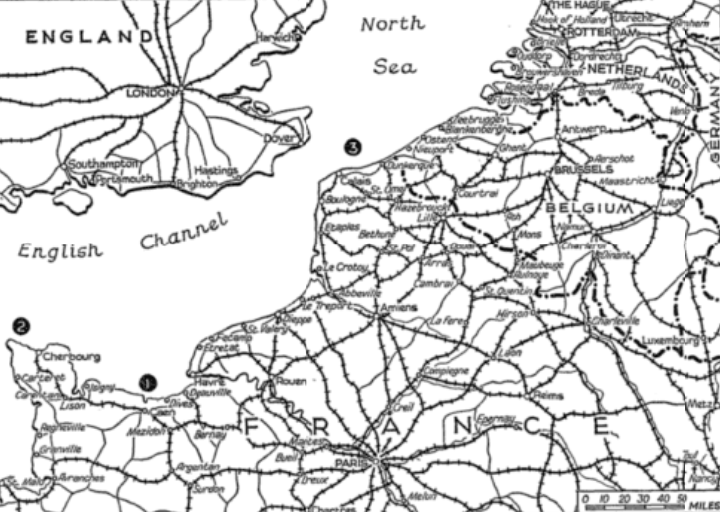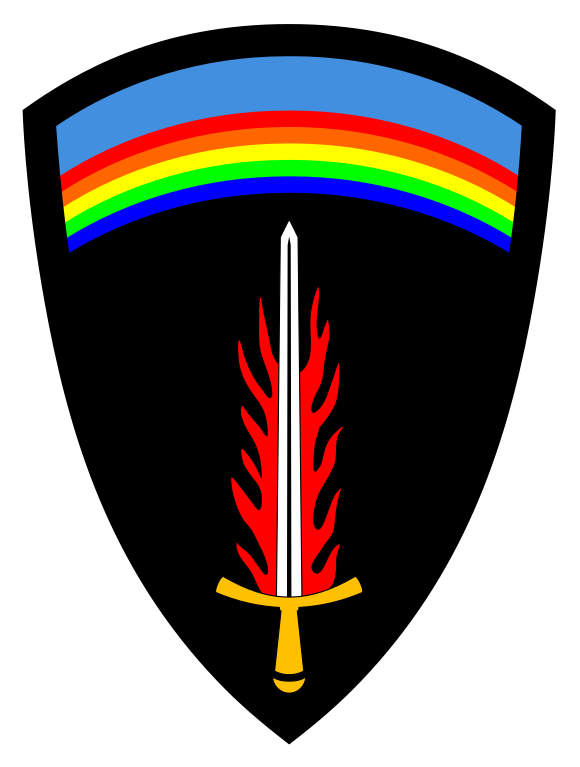The New York Times (June 6, 1944)
ALLIED ARMIES LAND IN FRANCE IN THE HAVRE-CHERBOURG AREA; GREAT INVASION IS UNDERWAY
Eisenhower acts; U.S., British, Canadian troops backed by sea, air forces; Montgomery leads
Nazis say their shock units are battling our parachutists
By Raymond Daniell
First Allied landing made on shores of Western Europe

Gen. Eisenhower’s armies invaded northern France this morning. While the landing points were not specified, the Germans said that troops had gone ashore near Le Havre and that fighting raged at Caen (1). The enemy also said that parachutists had descended at the northern tip of the Normandy Peninsula (2) and heavy bombing had been visited on Calais and Dunkerque (3).
SHEAF, England –
The invasion of Europe from the west has begun.
In the gray light of a summer dawn, Gen. Dwight D. Eisenhower threw his great Anglo-American force into action today for the liberation of the continent. The spearhead of attack was an Army group commanded by Gen. Sir Bernard L. Montgomery and comprising troops of the United States, Britain and Canada.
Gen. Eisenhower’s first communiqué was terse and calculated to give little information to the enemy. It said merely that:
Allied naval forces supported by strong air forces began landing Allied armies this morning on the northern coast of France.
After the first communiqué was released, it was announced that the Allied landing was in Normandy.
Caen battle reported
German broadcasts, beginning at 6:30 a.m. London Time (12:30 a.m. EWT) gave first word of the assault.
The Associated Press said Gen. Eisenhower, for the sake of surprise, deliberately let the Germans have the “first word.”
The German DNB Agency said the Allied invasion operations began with the landing of airborne troops in the area of the mouth of the Seine River.
Berlin said the “center of gravity” of the fierce fighting was at Caen, 30 miles southwest of Le Havre and 65 miles southeast of Cherbourg, the Associated Press reported. Caen is 10 miles inland from the sea, at the base of the 75-mile-wide Normandy Peninsula, and fighting there might indicate the Allies’ seizing of a beachhead.
DNB said in a broadcast just before 10:00 a.m. (4: 00 a.m. EWT) that the Anglo-American troops had been reinforced at dawn at the mouth of the Seine River in the Le Havre area.
…
Invasion leaders of Allied forces
‘Thumbnail’ sketches of men who are directing blows against Hitler’s West Wall
By the Associated Press
SUPREME ALLIED COMMANDER: Gen. Dwight David Eisenhower, 53, Texas-born, Kansas-reared; previously Allied commander of the forces in North Africa, Sicily and Italy.
DEPUTY SUPREME ALLIED COMMANDER: Air Chf. Mshl. Sir Arthur Tedder, 52, Briton who turned to the air after having been wounded as an infantryman in World War I; successful commander of Middle East and Allied Mediterranean Air Forces.
ALLIED NAVAL COMMANDER: Adm. Sir Bertram Home Ramsay, 61, the man who brought the British Army home from Dunkerque, planner of sea participation in North African and Sicilian campaigns.
ALLIED AIR FORCES COMMANDER: Air Chf. Mshl. Trafford Leigh Leigh-Mallory, 52, career airman, son of British clergyman, formerly commander of all British-based RAF fighters.
BRITISH GROUND FORCES COMMANDER: Gen. Sir Bernard Law Montgomery, 56, another clergyman’s son, hero of 8th Army victory at El Alamein and push across Africa and Sicily into Italy.
SENIOR U.S. GROUND FORCES OFFICER: Lt. Gen. Omar Nelson Bradley, 51, Missouri-born, quiet-mannered hero of U.S. victory at Bizerte, called “Doughboys’ General.”
COMMANDER, U.S. STRATEGIC AIR FORCES: Lt. Gen. Carl “Tooey” Spaatz, 53, Pennsylvania Dutch, endurance flier, founder of 8th Air Force and commander of U.S. Air Forces in Mediterranean victories.
CHIEF OF STAFF TO GEN. EISENHOWER: Lt. Gen. Walter Bedell Smith, 48, native of Indiana, Gen. Eisenhower’s Chief of Staff for North African invasion.
COMMANDER, U.S. 8TH AIR FORCE: Lt. Gen. James H. “Jimmy” Doolittle, 47, one of the world’s most noted pilots, “the man who bombed Tokyo.”
COMMANDER, U.S. 9TH TACTICAL AIR FORCE: Lt. Gen. Lewis H. Brereton, 54, Pennsylvania-born, went to Annapolis but joined Army after graduation, was air commander in the Philippines, Java, India and the Middle East; noted for driving energy.
COMMANDER, RAF BOMBER FORCE: Air Chf. Mshl. Sir Arthur T. Harris, 52, took over present post in 1942 and has since been trying to bomb Germany out of the war by mass “saturation” technique which he organized.
COMMANDER, BRITISH 2ND TACTICAL AIR FORCE: Air Marshal Sir Arthur Coningham, 49, veteran of all kinds of air fighting, scored great success with RAF Desert Air Force and then commanded all Allied tactical operations in Tunisian and Sicilian campaigns; was cavalryman and fighter pilot in World War I.


